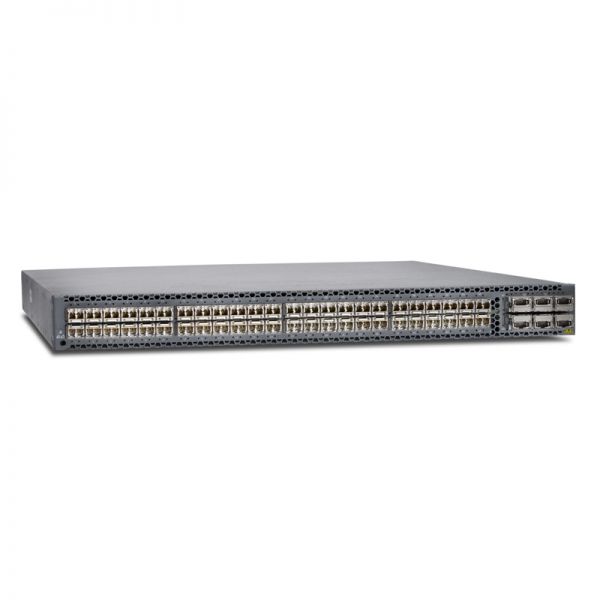Thông Số Kỹ Thuật QFX5100-48S-DC-AFO
| Hardware | |
| CPU | 1.5 GHz dual-core Intel |
| RAM | 8 GB memory |
| Storage | 32 GB SSD storage |
| Switching Capacity | 1.44 Tbps/1.08 Bpps |
| Weight | 21.8 lb (9.9 kg) |
| Dimensions (HxWxD) | 1.72 x17.36 x 20.48 in (4.37 x 44.09 x 52.02 cm) |
| Dimensions (W x H x D) | • 17.41 x 1.72 x 16.43 in. (44.21 x 4.32 x 41.73 cm) • Desktop installation width noted above, rack-mount width: 17.5 in, (44.5 cm) • Height: 1 U |
| Switching mode | Cut-through and store-and-forward |
| Airflow | front-to-back |
| Power Consumption | 150 W |
| Interface Options | – 1GbE SFP: 48 (24 copper 1GbE) – 10GbE SFP+: 48/72 (with breakout cable) – 40GbE QSFP+: 6 |
| Rack Installation Kit | Versatile four post mounting options for 19-in server rack or datacom rack |
| Power Supply and Fan Modules | • Dual redundant (1+1) and hot-pluggable power supplies • -36 to -72 V DC power • Redundant (N+1) and hot-pluggable fan modules for front-to-back airflow |
| Performance Scale (Unidimensional) | • MAC addresses per system: 288,0003 • VLAN IDs: 4,096 • Number of link aggregation groups (LAGs): 128 • Number of ports per LAG: 32 • Number of FCoE VLANs/FC Virtual Fabrics: 4,095 • Firewall filters: 4000 • IPv4 unicast routes: 128,000 prefixes; 208,000 host routes; 644 ECMP paths • IPv4 multicast routes: 104,000 • IPv6 multicast routes: 52,000 • IPv6 unicast routes: 64,000 prefixes • ARP entries: 48,000 • Jumbo frame: 9,216 bytes • Spanning Tree Protocol (STP) – Multiple Spanning Tree Protocol (MSTP) instances: 64 – VLAN Spanning Tree Protocol (VSTP) instances: 253 • Traffic mirroring – Mirroring destination ports per switch: 4 – Maximum number of mirroring sessions: 4 – Mirroring destination VLANs per switch: 4 |
| Layer 2 Features | • STP—IEEE 802.1D (802.1D-2004) • Rapid Spanning Tree Protocol (RSTP) (IEEE 802.1w); MSTP (IEEE 802.1s) • Bridge protocol data unit (BPDU) protect • Loop protect • Root protect • RSTP and VSTP running concurrently • VLAN—IEEE 802.1Q VLAN trunking • Routed VLAN Interface (RVI) • Port-based VLAN • MAC address filtering • Private VLAN (PVLAN) • QinQ • VLAN Translation • Static MAC address assignment for interface • Per VLAN MAC learning (limit) • MAC learning disable • Link Aggregation and Link Aggregation Control Protocol (LACP) (IEEE 802.3ad) • IEEE 802.1AB Link Layer Discovery Protocol (LLDP) |
| Link Aggregation | • Multi-chassis link aggregation (MC-LAG) • Redundant Trunk Group (RTG) • LAG load sharing algorithm—bridged or routed (unicast or multicast) traffic: – IP: SIP, Dynamic Internet Protocol (DIP), TCP/UDP source port, TCP/UDP destination port – Layer 2 and non-IP: MAC SA, MAC DA, Ethertype, VLAN ID, source port – FCoE packet: Source ID (SID), Destination ID (DID), Originator exchange ID (OXID), source port |
| Layer 3 Features (IPv4) | • Static routing • Routing policy • Routing protocols (RIP, OSPF, IS-IS, BGP) • Virtual Router Redundancy Protocol (VRRP) • Bidirectional Forwarding Detection (BFD) protocol • Virtual router • Dynamic Host Configuration Protocol (DHCP) relay • Proxy Address Resolution Protocol (ARP) |
| Multicast Features | • Internet Group Management Protocol (IGMP): v1, v2 , V3 • IGMP snooping: v1, v2, v3 • IGMP Filter • PIM-SM • Multicast Source Discovery Protocol (MSDP) |
| Security and Filters | • Secure interface login and password • RADIUS • TACACS+ • Ingress and egress filters: Allow and deny, port filters, VLAN filters, and routed filters, including management port filters • Filter actions: Logging, system logging, reject, mirror to an interface, counters, assign forwarding class, permit, drop, police, mark • SSH v1, v2 • Static ARP support • Storm control, port error disable, and autorecovery • Control plane denial-of-service (DoS) protection • Dynamic ARP Inspection (DAI) • Sticky MAC address • DHCP snooping |
| Quality of Service (QoS) | • L2 and L3 QoS: Classification, rewrite, queuing • Rate limiting: – Ingress policing: 1 rate 2 color, 2 rate 3 color – Egress policing: Policer, policer mark down action – Egress shaping: Per queue on each port • 12 hardware queues per port (8 unicast and 4 multicast) • Strict priority queuing (LLQ), smoothed deficit weighted round-robin (SDWRR), weighted random early detection (WRED), weighted tail drop • 802.1p remarking • Layer 2 classification criteria: Interface, MAC address, Ethertype, 802.1p, VLAN • Congestion avoidance capabilities: WRED • Trust IEEE 802.1p (ingress) • Remarking of bridged packets |
| Data Center Bridging (DCB) | • Priority-based flow control (PFC)—IEEE 802.1Qbb • Enhanced Transmission Selection (ETS)—IEEE 802.1Qaz • Data Center Bridging Exchange Protocol (DCBX), DCBx FCoE, and iSCSI type, length, and value (TLVs) |
| Fibre Channel over Ethernet (FCoE) | • FCoE transit switch (FIP snooping ACL installation) • FCoE session path learning • FCoE session health monitoring • Graceful restart for FIP snooping • FC-BB-6 VN2VN snooping |
| Virtual Chassis | • 40GbE and 10GbE as Virtual Chassis port • Virtual Chassis Routing Engine (RE) election • Virtual Chassis pre-provisioning (plug and play) • Auto-LAG formation of Virtual Chassis ports • Mixed Virtual Chassis support • FCoE transit across Virtual Chassis members • QoS on Virtual Chassis ports • Local Designated Forwarding • Graceful RE switchover (GRES) • Nonstop routing (NSR) • Nonstop bridging (NSB) • Monitor distributed aggregate interface • Control plane protection for virtual RE |
| High Availability | • Topology-independent in-service software upgrade (TISSU) • Bidirectional Forwarding Detection (BFD) • Uplink failure detection (UFD) |
| MPLS | • Static label-switched paths (LSPs) • RSVP-based signaling of LSPs • LDP-based signaling of LSPs • LDP tunneling (LDP over RSVP) • MPLS class of service (CoS) • MPLS access control list (ACL)/policers • MPLS LSR support • IPv6 tunneling (6PE) (via IPv4 MPLS backbone) • MPLS Operation, Administration, and Maintenance (OAM)— LSP ping • IPv4 L3 VPN (RFC 2547, 4364) |
| Server Virtualization Management and SDN-Related Protocols | • Junos Space Virtual Control • IEEE 802.1Qbg (VEPA hairpin forwarding) • VMware NSX VXLAN L2 Gateway • VXLAN OVSDB • OpenFlow 1.3 client |
| Management and Operations | • Management and Operations • Contrail Networking • Junos Space Network Director • Role-based CLI management and access • CLI via console, telnet, or SSH • Extended ping and traceroute • Junos OS configuration rescue and rollback • Image rollback • SNMP v1/v2/v3 • Junos XML management protocol • sFlow v5 • High frequency statistics collection • Beacon LED for port and system • Automation and orchestration • Zero-touch provisioning (ZTP) • OpenStack Neutron Plug-in • Puppet • Chef • Python • Junos OS event, commit, and OP scripts |
| Traffic Mirroring | • Port-based • LAG port • VLAN-based • Filter-based • Mirror to local • Mirror to remote destinations (L2 over VLAN) |
| Standards Compliance | |
| IEEE Standard | IEEE standard, IEEE 802.1D, IEEE 802.1w, IEEE 802.1, IEEE 802.1Q, IEEE 802.1p, IEEE 802.1ad, IEEE 802.3ad, IEEE 802.1AB, IEEE 802.3x, IEEE 802.1Qbb, IEEE 802.1Qaz, IEEE 802.3an |
| T11 Standards | INCITS T11 FC-BB-5 |
| Safety | • CAN/CSA-C22.2 No. 60950-1 (2007) Information Technology Equipment—Safety • UL 60950-1 (2nd Ed.) Information Technology Equipment— Safety • EN 60950-1 (2005) Information Technology Equipment— Safety • IEC 60950-1 (2005) Information Technology Equipment— Safety (All country deviations): CB Scheme report. • EN 60825-1 +A1+A2 (1994) Safety of Laser Products—Part 1: Equipment Classification • GR-63-Core (2006) Network Equipment, Building Systems (NEBS) Physical Protection • GR-1089-Core (2006) EMC and Electrical Safety for Network Telecommunications Equipment • SR-3580 (1995) NEBS Criteria Levels (Level 3) |
| EMC | • FCC 47CFR, Part 15 Class A (2009) USA Radiated Emissions • EN 55022 Class A (2006)+ A1 2007 European Radiated Emissions • VCCI Class A (2007) Japanese Radiated Emissions • BSMI CNS 13438 and NCC C6357 Taiwan Radiated Emissions • AS/NZS CISPR22:2009 |
| Environmental Ranges | • Operating temperature: 32° to 104° F (0° to 40° C) • Storage temperature: -40° to 158° F (-40° to 70° C) • Operating altitude: up to 2,000 (610 m) • Relative humidity operating: 5% to 90% (noncondensing) • Relative humidity non-operating: 0% to 95% (noncondensing) |




Đánh giá